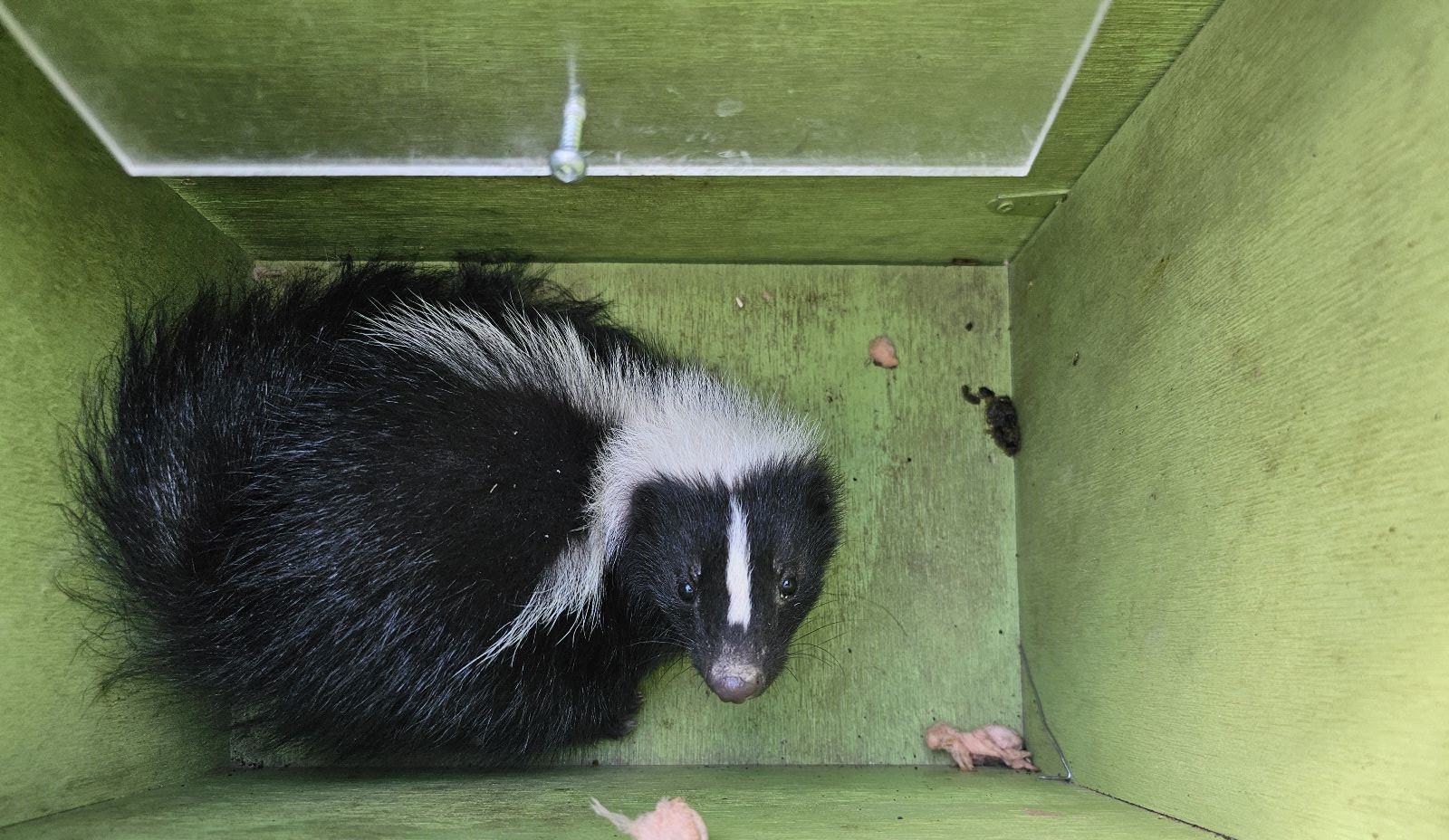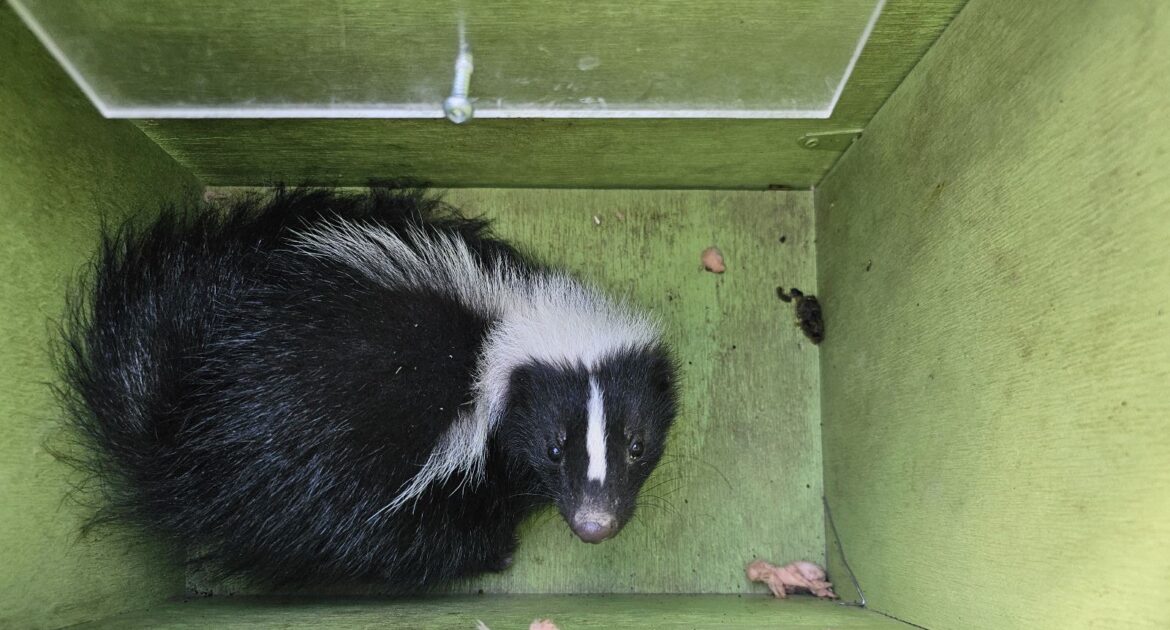Encountering a skunk can be a surprising and often humorous experience for many, but the myths surrounding their notorious spray can lead to unnecessary panic. One common misconception is that skunk spray is flammable; however, the truth is that while it has a strong and pungent odour, it is not considered flammable. Understanding this fact can help ease some fears, allowing us to appreciate these creatures for what they are rather than focusing solely on their defensive tactics.
At Skedaddle Humane Wildlife Control in Pickering, we believe that knowledge is key to coexistence with wildlife. Skunk encounters, while often amusing, can also raise genuine safety concerns for pet owners and families.
In this blog, we’ll delve deeper into the properties of skunk spray, explore some of the prevalent myths and truths about these fascinating animals, and offer practical advice on how to handle an encounter with a skunk. From dispelling the flames of fear to providing insights on humane deterrents, we’ve got you covered!
What Is Skunk Spray?
This powerful defence mechanism is more than just an unpleasant odour; it’s a chemical concoction designed for survival. At the heart of its potency lies a mix of compounds known as thiols and thioacetates. These compounds are volatile and rich in sulphur, contributing to the obnoxiously strong scent that can linger for days.
Thiols are the main players responsible for that instantly recognizable smell. When a certain creature feels threatened, it releases these compounds, which are quick to alert any nearby intruders to retreat. Thioacetates play a supportive role. They convert into thiols upon exposure to water or air, extending the lifespan of the smell and making it even more challenging to eliminate. This chemical complexity not only underscores the effectiveness of this animal’s defence but also raises questions about its potential for combustion.
Investigating Flammability
When discussing whether the infamous spray poses any flammability risk, it’s important to delve into the chemical properties that contribute to its composition. The key components, namely thiols, possess low flash points, meaning they can ignite at relatively low temperatures when in their pure form.
However, when these compounds are combined in the mixture found in nature, their overall volatility diminishes. Scientific studies have explored the flammability of various organic compounds, revealing that while some thiols can ignite under certain conditions, the combination of factors in the spray reduces the risk significantly.
Experiments conducted in controlled environments aimed to test the ignition potential of the concentrated elements have shown that, despite their individual characteristics, the spray lacks the necessary conditions to burn. Additionally, it’s important to note that the strong, lingering scent typically prevents proximity; thus, the potential for igniting such substances is further minimized.
Understanding the science behind this mixture allows us to reassure ourselves and our communities. It highlights that, although the spray might not be entirely without its hazards, the fear of flammability is largely unfounded. It’s crucial for us to focus on coexistence strategies rather than dwelling on unsubstantiated fears.
Safety Concerns with Skunk Spray
While the flammability of skunk spray is a valid topic of discussion, our primary focus should be on the direct concerns related to exposure and the potential impacts it may have. Understanding these effects can better prepare us for encounters and help us respond effectively. Here, we outline the key concerns associated with the spray:
- Odour Persistence: The most immediate effect we experience is the intense and lingering odour that can permeate clothing, fur, and any surfaces in proximity. This smell can be overwhelming and may take several days to dissipate, leading to discomfort and necessitating a thorough cleaning process.
- Eye Irritation: Exposure to spray can cause significant irritation to the eyes, leading to tearing, redness, and a burning sensation. It’s essential to flush the eyes with water immediately if exposed, and if symptoms persist, seeking medical attention is advisable.
- Respiratory Issues: Inhaling the compounds found in the spray can lead to respiratory distress for some individuals, particularly those with pre-existing conditions such as asthma. Symptoms may include coughing, difficulty breathing, and throat irritation, warranting fresh air and possibly medical evaluation.
- Skin Reactions: Direct contact with the spray may result in skin irritation or allergic reactions. Symptoms can include redness, itching, and swelling. It’s crucial to wash the affected area with soap and water to alleviate these reactions.
Understanding these effects allows us to prepare for encounters and equips us with the knowledge to respond appropriately. While we can take steps to minimize the risk of exposure, it is essential to approach any potential encounter with caution and respect for these fascinating creatures. By focusing on safe practices, we can coexist more harmoniously with wildlife while dispelling unnecessary fears.
What to Do If You’re Skunk Sprayed
Encountering a skunk and experiencing its spray can be a distressing situation. However, knowing the right steps to take can mitigate its effects and ensure your safety and well-being. Our tips will guide you through the essential actions to take if you’re exposed to this potent substance.
- Stay Calm and Move Away: The first instinct might be to panic, but staying calm is crucial. Move away from the area to avoid prolonged exposure to the odour and to give yourself space to assess the situation. This also helps you avoid disturbing the skunk, which may act defensively.
- Avoid Touching Your Face: If sprayed, refrain from touching your face, especially your eyes and mouth. The compounds in the spray can cause significant irritation, so keeping your hands away from these sensitive areas is essential.
- Wash Affected Areas Immediately: Rinse any exposed skin with soap and water as soon as possible. A thorough wash can help reduce the intensity of the odour and soothe your skin, diminishing irritation. If the substance is on your clothes, change out of them to prevent further contact.
- Flush Your Eyes: If the spray contacts your eyes, flush them immediately with plenty of water. This action can alleviate irritation and discomfort. If your symptoms persist or worsen, seek medical help promptly.
- Control your Breathing: If you inhale the spray, move to fresh air as soon as you can. Breathing deeply and slowly can help calm any respiratory distress. If you have pre-existing conditions, be mindful of your symptoms and consider seeking medical attention.
- Seek Medical Attention if Necessary: If adverse health effects occur, such as difficulty breathing or severe skin reactions, do not hesitate to seek medical assistance. It’s crucial to be vigilant about your health and to ensure any irritation is addressed.
By following these tips, we can ensure both safety and health when faced with such an unexpected encounter. Remember, knowledge and swift action allow us to handle these situations with confidence, fostering a respectful coexistence with wildlife.
Myth vs. Reality
When it comes to understanding the nature of that particularly pungent defensive secretion, many misconceptions circulate. One of the most common myths is that this odourant is highly flammable, which often leads to undue panic in situations where we might encounter it.
In fact, while some organic compounds in various products may pose a fire risk under specific conditions, the overwhelming consensus is that the composition of this spray does not make it notably flammable. Rather, our focus should shift toward the legitimate concerns associated with exposure, such as irritation and the lingering smell, which are far more pressing issues than any exaggerated fears regarding ignition.
By separating fact from fiction, we can better prepare ourselves for an encounter and lessen our anxiety over unfounded concerns. Understanding the realities surrounding this substance empowers us to cohabit peacefully with these intriguing creatures instead of succumbing to myths that can lead to unnecessary stress. So, the next time we hear tales about the dramatic risks of encountering an odorous animal, let’s rely on facts to keep our perspective balanced.
Safety And Odour Control
The intriguing question of whether the notorious spray can ignite leads us to a deeper understanding of its composition and effects. While theoretically possible, the practical risk of such an event occurring is minimal. The real concerns lie in the immediate aftermath, where safety and odor control become the priorities.
Whether you’re dealing with an unexpected encounter or seeking preventative measures, remember that Skedaddle Humane Wildlife Control in Pickering is ready to assist. Our humane approach, focusing on two-way doors to guide wildlife out, provides a compassionate solution. If you’re facing challenges from these animals or others, contact us to request a quote and learn more about our services. Your peace of mind is our mission.




